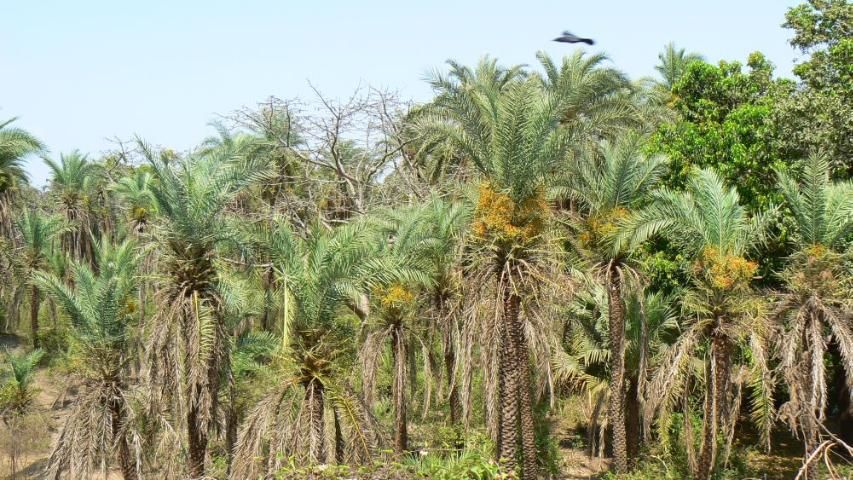Family
Arecaceae, palm family.
Genus
Phoenix is the Latin term for the Greek word that means "date palm."
Species
The species name sylvestris translates from the Latin term for "of the forest."
Common Names
Wild Date Palm, Toddy Palm, Sugar Date Palm, Silver Date Palm
This palm produces edible fruits but it is generally called "wild date palm" to distinguish it from the closely related Phoenix dactylifera, which is known as "date palm" and is cultivated agriculturally as the commercial source of edible dates. This palm is a major source of sugar in India, and the sap is sometimes fermented into a drink called a "toddy," which explains the names "sugar date palm" and "toddy palm." The common name "silver date palm" probably refers to the silvery green foliage.
Description
This palm is native to India and southern portions of Pakistan. In both countries, it occurs in areas where there is sparse vegetation mainly composed of scrub species and along flat lands where monsoons occur. Though slow growing, it can reach heights of up to 50 feet and grows well in areas of the United States where temperatures do not fall below 15°F. Leaves are pinnately compound and blue-green, and they can grow to 10 feet in length. Leaflets can reach approximately 18 inches long and grow opposite to one another on the rachis in such a way that the entire leaf looks flat. The petiole, or stem that attaches the leaf to the trunk, is 3 feet long and armed with spines. Young trunks bear triangular shaped leaf scars (the place where leaves once attached to the trunk) that become more diamond-shaped with age. On older trees, aerial roots tend to be present at the base of the trunk. Yellow inflorescences can reach lengths of 3 feet, are heavily branched, bear small white blossoms, and grow among the leaves. The oblong fruits are 1 inch long and occur in orange clusters, turning dark red to purple when mature.

Credit: Dinesh Valke, CC BY-NC-ND 2.0

Credit: Hari Prasad Nadig, CC BY-SA 2.0
Allergen
Each individual tree is either a male or a female (as is true for all species within this genus). Male trees are extremely allergenic because their pollen is air-borne, whereas female palms cause minimal to no allergies.
Applications
Commercial/Practical
In India, sugar and alcohol are made from wild date palm flowers and jelly is made from the fruit.
Horticultural
The wild date palm is an attractive landscape specimen with its blue-green leaves, textured trunk, and yellow inflorescences. The canopy of this palm is dense, exhibits a round shape, and can provide light shade. This palm will thrive and show the best growth when it is planted in direct sunlight. Wild date palm is drought tolerant and prefers well-drained sandy soils, but it grows better when regularly watered. This species is susceptible to lethal yellowing disease (https://edis.ifas.ufl.edu/pp146), so it is best to avoid planting wild date palm where the disease is known to be present.
References
Borror, D. J. 1988. Dictionary of root words and combining forms (2nd ed.). Mountain View, CA: Mayfield Publishing Company.
Coombes, A. 1994. Dictionary of plant names: Botanical names and their common name equivalents. Portland, OR: Timber Press.
Floridata.com. 2004. Phoenix dactylifera, Retrieved from http://www.floridata.com/ref/p/phoe_dac.cfm
Harrison, N. A. and M. L. Elliot. 2009. Lethal yellowing (LY) of palm (PP146). Gainesville, FL: UF-IFAS Florida Cooperative Extension Service. Retrieved from https://edis.ifas.ufl.edu/pp146
Meerow, A. W. 2004. Betrock's guide to landscape palms (9th ed.). Hollywood, FL: Betrock Information Systems.
Ogren, T. L. 2000. Allergy-free gardening: The revolutionary guide to healthy landscaping. Berkeley, CA: Ten Speed Press.
Riffle, R. L. and P. Craft. 2003. An encyclopedia of cultivated palms. Portland, OR: Timber Press, Inc.